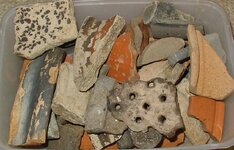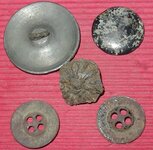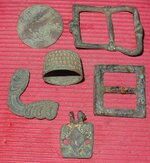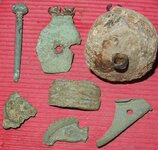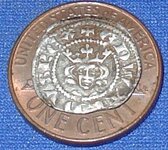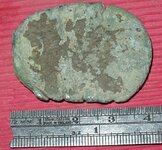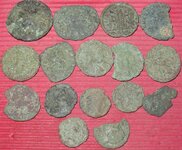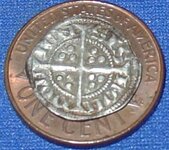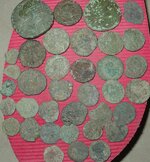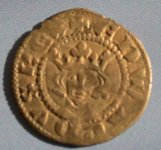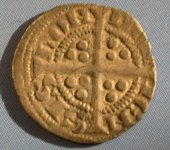CRUSADER
Gold Member
Fan's Roman Site - Day 2 - Great Day!!!
Those that follow, will know I'm not one to waste holidays lieing on the beach. I'm always out in a field & this time its a Wheat Stubble field in pretty good condition for Wheat, as it was fairly easy to work. Conditions were OK most the time (a little hot) & we had a great view for the picnic.
We spent 6 hours 45 minutes trying to map the limits of this new site. The pot shards & roof tile bits along with the butchered bone tell us my hunch was right & this is where the Metal workers lived. Just a short distance from their workshops. (800+metres)
We predicted 50 bronze & 1 silver & were only wrong on the silver, strange really. (after getting 82 bronze)
(after getting 82 bronze)
52 Bronze Roman Coins (only some pictured, the rest to follow) - Best 1 Day Total this year!
New Emporer (for us) - Volvsian AD251-53
Roman Brooch Bits
Roman Hair Pin
Roman Steelyard Weight
Medieval Horse Harness Hanger
Jetton
Flatten Sesterius. Very odd as the proccess to roll metal wasn't invented until another 1000 years. If it were hammered, it was hammered indirectly with anther roller type object. I will have the experts check it out.
Very odd as the proccess to roll metal wasn't invented until another 1000 years. If it were hammered, it was hammered indirectly with anther roller type object. I will have the experts check it out.
Evidence of metal working - blobs & broken bits..
My star find, just 15-20 metres from the car on the way back! Is a RARE Edward I Farthing in specimen condition. (better than book examples) Its the LONDONIENSIS type but I can't match it to any 'known' class. I will research a good contact.
Those that follow, will know I'm not one to waste holidays lieing on the beach. I'm always out in a field & this time its a Wheat Stubble field in pretty good condition for Wheat, as it was fairly easy to work. Conditions were OK most the time (a little hot) & we had a great view for the picnic.
We spent 6 hours 45 minutes trying to map the limits of this new site. The pot shards & roof tile bits along with the butchered bone tell us my hunch was right & this is where the Metal workers lived. Just a short distance from their workshops. (800+metres)
We predicted 50 bronze & 1 silver & were only wrong on the silver, strange really.
52 Bronze Roman Coins (only some pictured, the rest to follow) - Best 1 Day Total this year!
New Emporer (for us) - Volvsian AD251-53
Roman Brooch Bits
Roman Hair Pin
Roman Steelyard Weight
Medieval Horse Harness Hanger
Jetton
Flatten Sesterius.
Evidence of metal working - blobs & broken bits..
My star find, just 15-20 metres from the car on the way back! Is a RARE Edward I Farthing in specimen condition. (better than book examples) Its the LONDONIENSIS type but I can't match it to any 'known' class. I will research a good contact.

Amazon Forum Fav 👍
Attachments
Last edited:
Upvote
11


